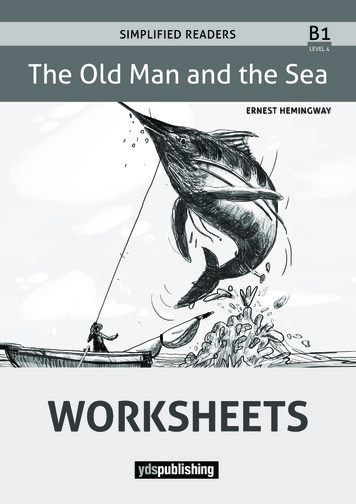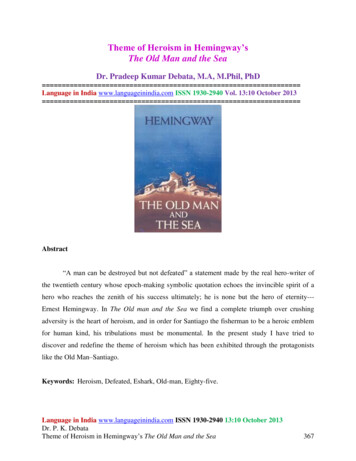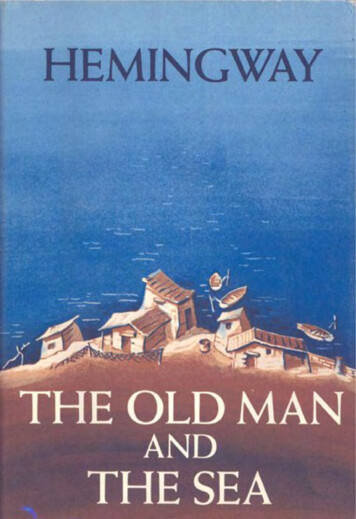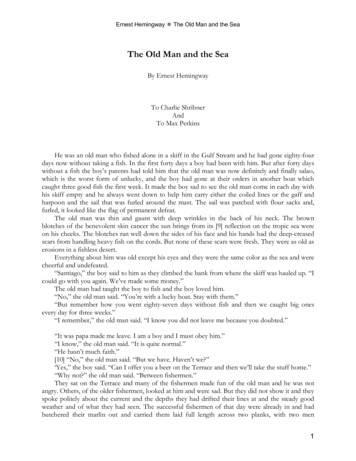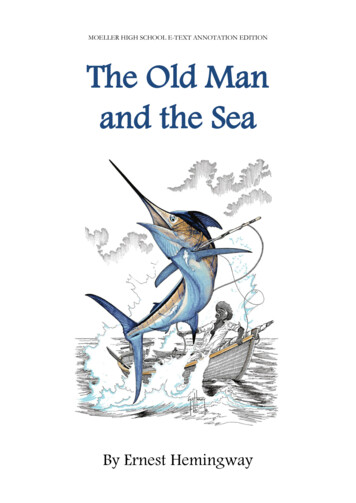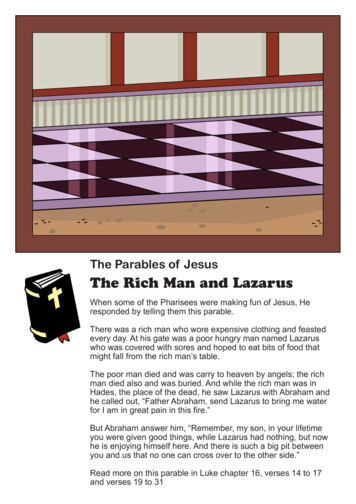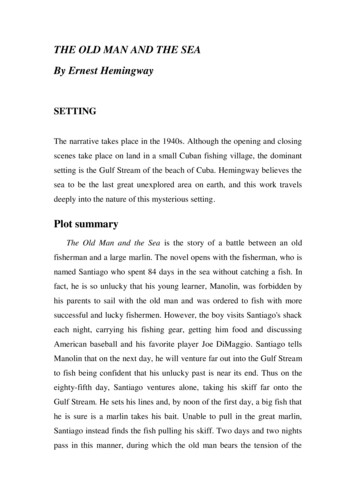
Transcription
THE OLD MAN AND THE SEABy Ernest HemingwaySETTINGThe narrative takes place in the 1940s. Although the opening and closingscenes take place on land in a small Cuban fishing village, the dominantsetting is the Gulf Stream of the beach of Cuba. Hemingway believes thesea to be the last great unexplored area on earth, and this work travelsdeeply into the nature of this mysterious setting.Plot summaryThe Old Man and the Sea is the story of a battle between an oldfisherman and a large marlin. The novel opens with the fisherman, who isnamed Santiago who spent 84 days in the sea without catching a fish. Infact, he is so unlucky that his young learner, Manolin, was forbidden byhis parents to sail with the old man and was ordered to fish with moresuccessful and lucky fishermen. However, the boy visits Santiago's shackeach night, carrying his fishing gear, getting him food and discussingAmerican baseball and his favorite player Joe DiMaggio. Santiago tellsManolin that on the next day, he will venture far out into the Gulf Streamto fish being confident that his unlucky past is near its end. Thus on theeighty-fifth day, Santiago ventures alone, taking his skiff far onto theGulf Stream. He sets his lines and, by noon of the first day, a big fish thathe is sure is a marlin takes his bait. Unable to pull in the great marlin,Santiago instead finds the fish pulling his skiff. Two days and two nightspass in this manner, during which the old man bears the tension of the
line with his body. Though he is wounded by the struggle and in pain,Santiago expresses a sympathy for his antagonist (marlin), often referringto him as a brother. He also determines that because of the fish's greatdignity, no one will be worthy of eating the marlin. On the third day ofthe battle, the fish begins to circle the skiff, indicating his tiredness to theold man. Santiago, now completely exhausted and almost in delirium,uses all the strength he has left in him to pull the fish onto its side andstab the marlin with a harpoon, ending the long battle between the oldman and the fish. Santiago straps the marlin to the side of his skiff andreturns home, thinking about the high price the fish will bring him at themarket and how many people he will feed. While Santiago continues hisjourney back to the shore, sharks are attracted to the blood left by themarlin in the water. The first, a great shark, Santiago kills with hisharpoon, but then he loses that weapon. He makes a new harpoon byfixing his knife to the end of an oar to help killing of sharks; in total, fivesharks are killed and many others are driven away. But the sharks keptcoming, and by sunset the sharks have almost eaten the marlin entirely,leaving a skeleton consisting mostly of its backbone, its tail and its head.Finally reaching the shore before dawn on the next day, Santiagostruggles on the way to his shack, carrying the mast on his shoulder. Athome, he slumps onto his bed and falls into a deep sleep. A group offishermen gather the next day around the boat where the fish's skeleton isstill attached. One of the fishermen measures it to be 18 feet (5.5 m) fromnose to tail. Tourists at the nearby café mistakenly take it for a shark.Manolin, worried during the old man's venture, cries upon finding himsafe asleep. The boy brings him newspapers and coffee. When the oldman wakes, they promise to fish together once again. Upon his return tosleep, Santiago dreams of his youth—of lions on an African beach.
MAIN THEMES'A man can be destroyed but not defeated.' , this line sums up themain theme in the story. Hemingway suggests that, although a personmay lose everything in the process of living, but being skillful, brave, andambitious results the final triumph of the human spirit. Hemingwayrejects the traditional happy ending in which Santiago, the poor oldfisherman, would bring home the great fish and sell it for a large amountof money at market. Instead, Santiago brings only the bare skeleton of themarlin into port, earning no money yet getting a far greater prize: ratherthan triumphing over nature, he achieves oneness with it.Other important theme in this novel centers on the relationship betweenSantiago and Manolin. The old man teaches the boy many importantthings like how to fish, and how to live with wisdom and dignity, on theother hand, the old man also has great need for the boy, especially whenhe is alone at sea and fishes the great fish. During his trying experiencewith the marlin, the old man repeatedly says, 'I wish I had the boy. Tohelp me and to see this.' The thematic statement, 'No one should be alonein their old age,' refers to the old man's loneliness and emphasizes thecharacters' relationship of respect and love.Another major theme is the oneness with nature. Santiago loves andrespects the fish that he kills. The old man finds it difficult to express theparadoxical love he feels for the fish: 'I do not understand these things,'he thinks, 'but it is good that we do not have to try to kill the sun or themoon or the stars. It is enough to live on the sea and kill our truebrothers'. Santiago also speaks to and loves the flying fish, the dolphins,and the noble marlin. The sea is also a part of the nature, perhaps themajor presence in the book. Santiago thinks of the sea as a woman, thinks
of it 'as la mar ,which is what people call her in Spanish when they loveher,' while the younger fisherman think of the sea as the masculine ' elmar ' and consider it 'a contestant or a place or even an enemy.'Character analysisSantiago : The old man of the novella’s title, Santiago is a Cubanfisherman who has had an extended run of bad luck. Despite hisexperiences in fishing, he has been unable to catch a fish for eighty-fourdays. He is humble, yet shows a justified pride in his abilities. Hisknowledge of the sea and its creatures, and of his craft, is unparalleledand helps him preserve a sense of hope regardless of circumstance.Throughout his life, Santiago has been presented with challenge to testhis strength and endurance. The marlin with which he struggles for threedays represents his greatest challenge. Paradoxically, although Santiagoultimately loses the fish, the marlin is also his greatest victory.The marlin - Santiago hooks the marlin, which measures eighteen feet,on the first afternoon of his fishing voyage. Because of the marlin’s greatsize, Santiago is unable to pull the fish in, and the two become engaged ina struggle. The fishing line serves as a symbol of the fraternal connectionSantiago feels with the fish. When the captured marlin is later destroyedby sharks, Santiago feels destroyed as well.Manolin - Manolin is Santiago’s apprentice and assistant. The old manfirst took him out on a boat when he was merely five years old. Becauseof Santiago’s recent bad luck, Manolin’s parents have forced the boy togo out on a different fishing boat. Manolin, however, still cares deeply forthe old man, to whom he continues to look as a advisor. His love for
Santiago is unmistakable as the two discuss baseball and as the youngboy asks help from villagers to improve the old man’s poor conditions.Joe DiMaggio - Although DiMaggio never appears in the novel, even sohe plays a significant role. Santiago worships him as a model of strengthand commitment, and his thoughts turn toward DiMaggio whenever heneeds to reassure himself of his own strength. Despite a painful bone spurthat might have crippled another player, DiMaggio went on to secure atriumphant career. He was a center fielder for the New York Yankeesfrom 1936 to 1951, and is often considered the best all-around playerever at that position.CONFLICTProtagonistSantiago, the old Cuban fisherman, is the protagonist. Though he isunlucky in not having caught a single fish in eighty- four days, he is stillhappy and optimistic, full with self- confidence and bravery in the face ofthe most difficult circumstances. He wins the sympathy and admiration ofthe reader for his qualities of love and humbleness under pressure.Although he loses his giant fish, Santiago is still a winner.AntagonistThe antagonist is the sea, a symbol of life, which steals from Santiago hisfinal victory. The real antagonist in the sea is the group of sharks that eatthe giant fish. Since the sea also provide the old fisherman with his living,
he sees the sea more as a challenge than an enemy. The sea also enablesSantiago to show supreme endurance.ClimaxThe climax in the story occurs when Santiago kills the fish and its bloodattracts the eager sharks nearby. His hopes of taking home his huge fishare gone when the sharks attack and eat the fish.The endingOn the level of the simple plot, the story ends as a tragedy because thesharks eat greedily the old man’s prize (marlin) while on a deepersymbolic level, the old man becomes heroic. He has conquered the sea(life) and the sharks (life’s cruel problems) by proving that mankind hasthe capacity to fight, to show grace under pressure, to survive, and to win,no matter how big the battle. The personal victory is all-important, and itbecomes unimportant whether man obtains the visible prize.The importance of the dream of the Lions on the BeachSantiago dreams his pleasant dream of the lions playing on the beaches ofAfrica three times. The first time is the night before he departs on histhree-day fishing expedition, the second occurs when he sleeps on theboat for a few hours in the middle of his struggle with the marlin, and thethird takes place at the very end of the book. In fact, the sober promise ofthe triumph and regeneration with which the novella closes is supportedby the final image of the lions. Because Santiago associates the lions withhis youth, the dream suggests the circular nature of life. Additionally,because Santiago imagines the lions, wild animals, playing, his dreamsuggests a harmony between the opposing forces—life and death, loveand hate, destruction and regeneration—of nature.
setting is the Gulf Stream of the beach of Cuba. Hemingway believes the sea to be the last great unexplored area on earth, and this work travels deeply into the nature of this mysterious setting. Plot summary The Old Man and the Sea is the story of a battle between an old fisherman and a large marlin.


